Traditional for our country water heating- complex and expensive at the installation stage. Therefore, many are looking for other options for heating rooms, cottages, cottages and apartments. The first thing that comes to mind is electric heating convectors. Installation is super simple: set it up or hang it up, plug it into a power outlet. All. You can warm up. The only limitation is whether the wiring can withstand such a load. The second is decent electricity bills, but they can be reduced by installing.
What is convection and convector
Convection is the process of heat transfer due to the movement of heated air. A convector is a device that heats air and promotes its movement. There are convectors in which heating occurs due to the circulation of coolant, then they are part of water heating. But we will talk about electric convectors, which convert electricity into heat, and air flows carry this heat throughout the room.
According to the installation method, convector electric heaters are wall-mounted, floor-mounted, in-floor (built in below floor level), baseboard and universal (installed on legs that come included or hung on the wall).

It is impossible to say which form of electric heating convectors is better. All forms are developed taking into account thermodynamics (at least, normal companies do this this way), so you base your choice only on your own preferences and on which design fits best into the design of the room. No one forbids installing electric convectors in one apartment, house or even in a room different types. The main thing is that the wiring can withstand.
Installation of electric heating convectors
The design of the electric convector is simple:
- a housing in which there are openings for air intake and exhaust;
- heating element;
- sensors and control and monitoring devices.
The case is heat-resistant plastic. The shape can be flat or convex, rectangular or square. The case has holes at the bottom - cold air is sucked into them. There are also holes in the top of the case. Heated air comes out of them. The air moves without stopping, and the room warms up.
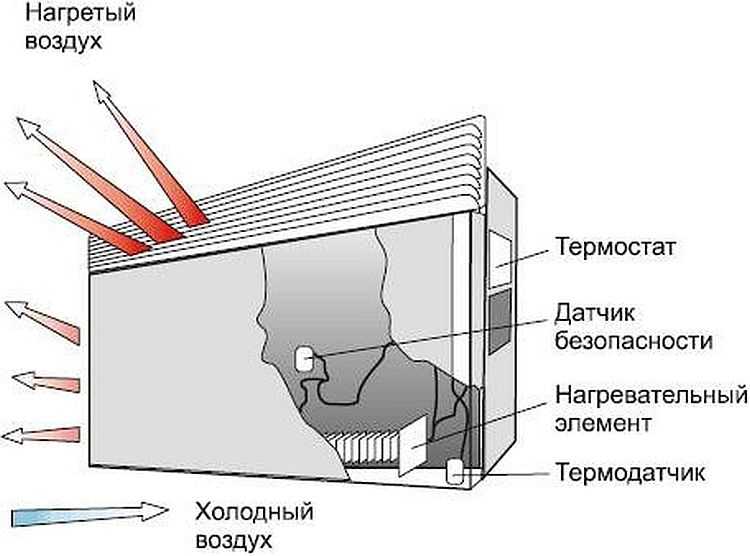
The heating element of an electric convector is what you need to pay attention to when choosing. The service life of the equipment and air conditioning depend on the type of heater.
Types of heating elements for electric convectors
There are three types of heating elements in electric heating convectors:
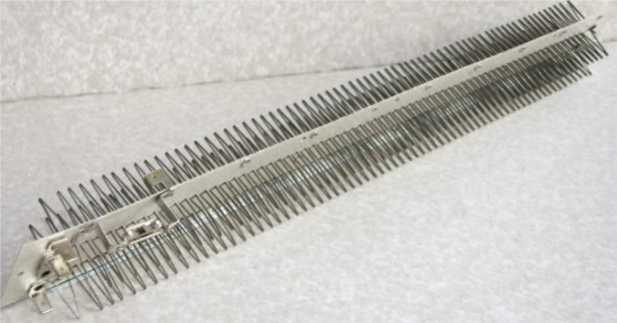
Electric heating convectors with monolithic heaters are considered the best, but they are also the most expensive. Using heating elements is a little cheaper.
Types of Thermostats and Controls
Electric heating convectors can be controlled using a mechanical thermostat or electronics. The cheapest convector electric heaters have a thermostat, which, when the set temperature is reached, breaks the power circuit of the heating element. When it cools down, the contact appears again and the heater starts working. This type of device cannot support constant temperature indoors - the thermostat is triggered by the heating of the contact plate, and not by the air temperature. But they are simple and quite reliable.

Electronic control uses several sensors that monitor the state of the air in the room and the degree of heating of the device itself. The data is processed by a microprocessor, which adjusts the operation of the heater. The desired mode is set from the control panel located on the case, and there are also models with a control panel. You can find programmable models that allow you to set the heating mode for a whole week - while no one is home, set it to maintain around +10°C or lower and save on bills; when people arrive, warm up the room to a comfortable temperature. There are generally “smart” models that can be integrated into the “smart home” system and controlled from a computer.
Choosing an installation location
Or rather, the question is not this: which convector is suitable for fulfilling your wishes. If you want to get closer appearance rooms to the standard one, you can hang rectangular wall convectors under the windows. Models that can be installed under the ceiling attract a little more attention, but they are inaccessible to children and pets - they will not be able to get burned or “adjust” in their own way. The installation method is the same here - on brackets fixed to the wall. Only the shape of the brackets differs.
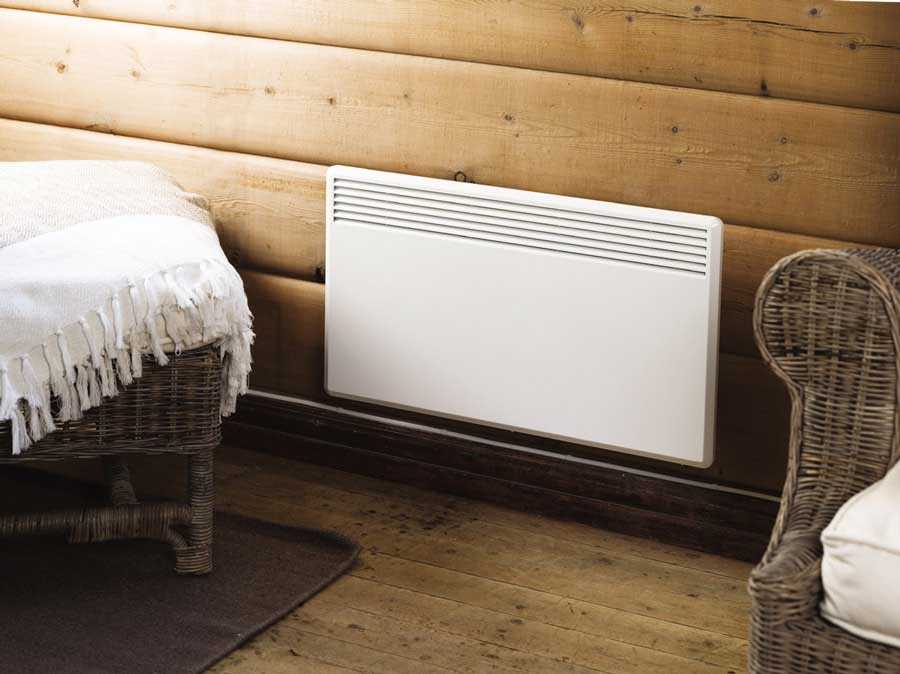
If you want your heating appliances not to be visible, you will have to choose between baseboard and in-floor models. There is a big difference in installation: the skirting boards are simply installed and connected to the network, but for the in-floor ones you will have to make special recesses in the floor - their top panel should be on the same level as the finished floor. In general, without overhaul you can't install them.
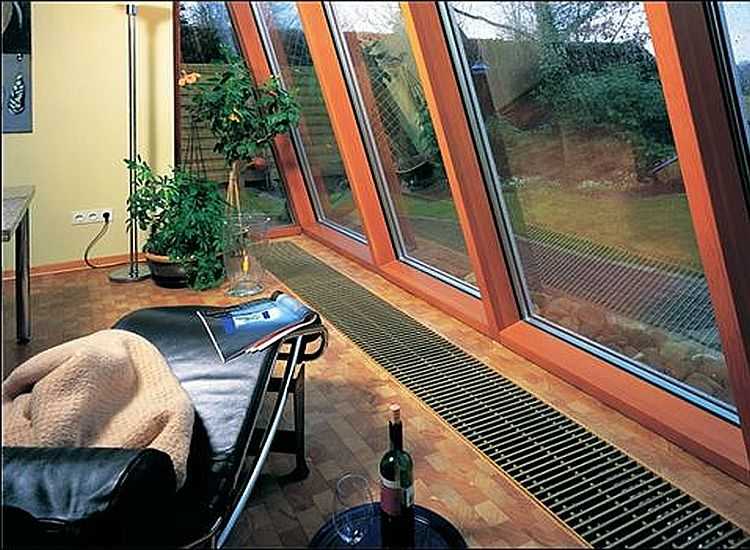
Power calculation
If a convector is needed only as an additional source of heat - for periods of extreme cold - it makes sense to take a couple of low-power devices - 1-1.5 kW each. They can be moved to those rooms where the temperature needs to be raised. If convector heating is the only source of heat, everything is much more serious.
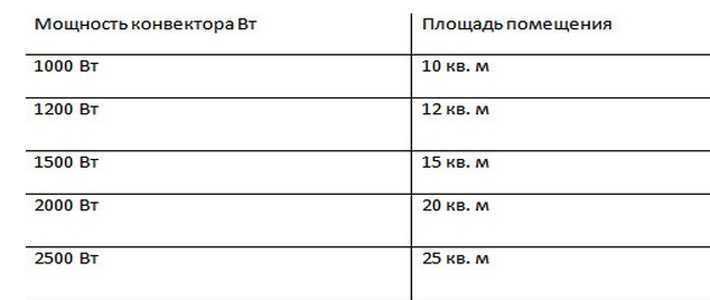
If you do everything “wisely,” you need to calculate the heat loss of a house or apartment and select equipment based on the calculation results. In fact, this is very rarely done. Much more often they think required power heating area: for heating 10 sq. m area requires 12 kW of heat. But these are the norms for average ceiling heights - 2.50-2.70 m and average insulation. If the ceilings are higher (the volume of air needs to be heated) or there is “no” insulation at all, the power is increased by 20-30%.
Manufacturers, characteristics and prices
Electric convector heaters are produced by several companies that produce other household appliances - Electrolux, AEG, Hyundai, Stiebel Eltron, Zanussi. In addition, there are many companies that specialize in this type of technology or produce two or three more groups of products. Among them there are Russian manufacturers— Ballu, Termica, Ural-Mikmah-Term, Alvin. There is also a whole group of European brands:
- Airele, Noirot and Atlantic (France),
- Extra, Royal Thermo, Scoole, Timberk, WWQ (PRC),
- Frico (Sweden),
- NeoClima (Greece),
- Nobo (Norway)
and many more. Electric heating is the norm in Europe; water heating is rare here. Hence the number of companies producing such household appliances. But, as usual in recent years, most companies have moved production to China, so the assembly is mainly Chinese, although quality control should be at the level.
Electric heating convectors can have a power from 0.5 kW to 2.5-3 kW. They operate mainly from a 220 V network; if necessary, three-phase ones can be found - from 380 V. With increasing power, the dimensions (mainly depth) and price increase. If we talk about prices on average, then the price for imported electric convectors is about $80-250, for Russian ones - $30-85.
| Name | Power | Additional functions | Installation type | Control type | Heating element type | Dimensions (D*W*H) | Price |
|---|---|---|---|---|---|---|---|
| AEG WKL | 0.5/1/1.5/2/2.5/3 kW | Overheat protection | Wall | Thermostat | heating element | 78*370*450 | 105 - 195 $ |
| Airelec Paris digital 05DG | 0.5 kW | Overheat protection | Wall | Electronic | Monolithic | 80*440*400 | 60-95 $ |
| Termica CE 1000 MR | 1 kW | Overheat protection + ionizer | Floor | Thermostat (mechanical) | heating element | 78*400*460 | 50 $ |
| Nobo C4F 15 XSC | 1.5 kW | Wall/floor | Electronic | heating element | 55*400*975 | 170 $ | |
| Stiebel Eltron CS 20 L | 2 kW | Overheat protection + fan | Floor | Thermostat (mechanical) | spiral heating element | 100*437*600 | 200-220 $ |
| Stiebel Eltron CON 20 S | 2 kW | Overheat protection | Floor | Thermostat (mechanical) | Stainless steel heating element | 123*460*740 | 450 $ |
| Noirot Melodie Evolution1500 | 1.5 kW | Overheat and tip-over shutdown | Wall-mounted (small height) | Electronic | Monolithic | 80*220*1300 | 300-350 $ |
| Ballu BEC/EVE - 1500 | 1.5 kW | Overheat and tip-over shutdown | Wall/floor | Electronic | Heating element Double G Force | 111*640*413 | 70 $ |
| Timberk TEC.PF1 M 1000 IN | 1 kW | Overheat and tip-over shutdown + ionizer | Wall/floor | Thermostat (mechanical) | 100*410*460 | 65 $ | |
| Dantex SD4-10 | 1 kW | Overheat and tip-over shutdown | Wall/floor | Electronic | Needle + quiet + economical | 78*640*400 | 45 $ |
Useful additional features
When choosing electric heating convectors, pay attention not only to technical parameters. There are also additional functions that increase comfort and safety:
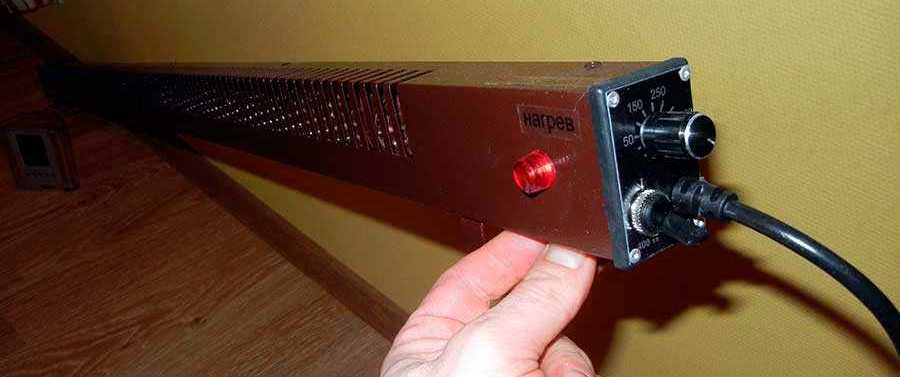
Overheat protection and drop shutdown - very useful features, increasing equipment safety. Something else you can pay attention to is how quiet or loud the unit is. It's not just the heating element (it usually clicks). When activated, the mechanical thermostat also clicks. When choosing convection heaters for your bedroom, quiet operation is very important.
- Infrared heater used as additional source heat
- Partial heating
- Heating using infrared heaters
Infrared heaters are not yet used in every apartment or office, but their popularity is growing due to their efficiency and advanced capabilities. Other heaters will not warm you on the veranda or in the gazebo, where all the heat is carried away by the air. And infrared heaters transmit thermal energy from the surface of the emitter directly onto heated objects, without heating the air. But in order to bask under the warm rays, you should correctly calculate the power of the heater: a more powerful one is more expensive and consumes more energy, while a weaker one may not be enough to achieve the desired temperature.
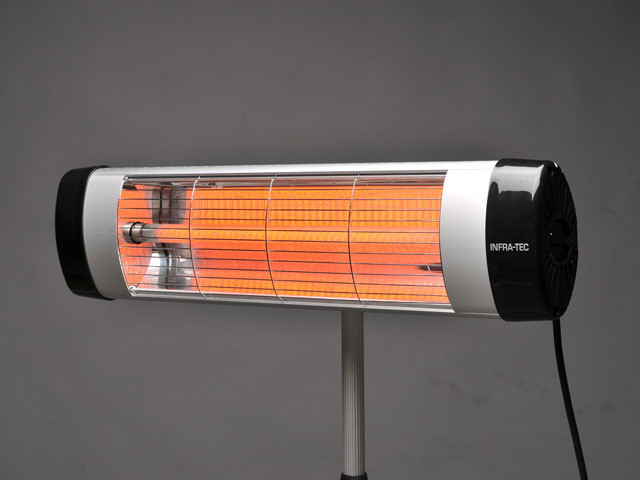
An IR heater is capable of uniformly heating the air in a room even in the presence of drafts.
The main characteristic in the calculation is the power density, measured in W/m2. It is defined as the ratio of the sum of the power of installed heaters to the floor area. The heater power is calculated taking into account the type of room: closed or open, with good or poor thermal insulation. It also depends on the expected temperature that the heating devices must maintain.
For those who use the most simplified calculations, experts recommend 1 kW of power per 10 m 2.
This will be enough to heat a room 3 m high with good thermal insulation.
Infrared heater used as an additional heat source

In this case, the operation of the device will have to cover the temperature difference environment and desired. Devices suitable for this purpose low power(300 W), which will ideally cope with this task. It is better to use portable floor heaters. When using them, a strategy is applicable: if you install the device further from the heating zone, the temperature will decrease, and if closer, it will increase. This is due to the fact that with distance, the area of propagation of the rays increases. Such manipulations will allow you to get the maximum comfortable conditions when the thermal environment changes. The average power value for additional heating is about 0.5 kW per 10 m 2 floor area.
Return to contents
Partial heating
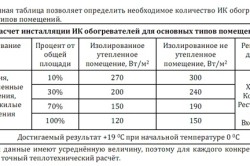
This method can be used for industrial and warehouse buildings, offices, shops, cafes, garages, that is, places not intended for permanent residence of people.
With the correct selection of power, the set temperature in the building will be established within 10 minutes after turning on the unit, which is very important for the comfort of workers during production process. But that's not all. There is no need to heat the entire area if only part of it is used. Infrared heaters can only warm the area of the workplace and only during working hours.
To calculate partial heating of industrial or residential premises, use the table:
The data is given for air heating from 0°C to +18°C.
As can be seen from the table, such heating requires more power than the average (1 kW per 10 m 2). In this case, savings occur due to a reduction in operating time and heated area, and the temperature controller will not allow excessive consumption of energy resources.
It's rare to meet a person who doesn't like warmth. Agree, much more comfortable to wear easy at home clothes, not cotton pants, a knitted sweater and wool socks, trying to stop shivering from the cold. In early autumn and late spring, as well as on cold summer evenings, when the heating does not work, only a high-quality heater can save freezing people. Why haven’t you acquired such a useful device yet? Then we will help you make an informed choice.
Main selection criteria
Where to start the search ideal option? Of course, with the main parameters that will help us decide quickly.
Heater type
- Oil heaters They are similar to a classic battery, as they consist of several sections, while they are often equipped with wheels and operate from the mains. They are quite ergonomic: they take up little space, do not require special care, and consume little electricity. The cost of such devices starts from 900 rubles. We do not recommend buying such heaters for a home where there are small children and pets, as they become very hot during operation and can burn curious researchers. In addition, oil heaters are not recommended for use in rooms with high humidity.
- Convector heater- a more efficient device that does not affect the composition of the air. It has higher efficiency than other heaters. The convector can be installed on the floor or mounted on the wall. Such devices can function for days without overheating. If you want a reliable heater for your home or office, we recommend that you consider this option, because it has virtually no drawbacks. In addition, the process of its operation can be programmed using a timer.
- Infrared heaters emit infrared waves that heat the surfaces of objects and human skin, without affecting the temperature and composition of the air. Their main advantage is efficient work in spacious rooms where it is difficult to warm the air with conventional heaters, however, when choosing, you need to pay attention to the maximum area of action. If you are looking for a heater for a large room or for a bathroom, then an infrared device is ideal for you.
- Carbon heaters- the most economical of all. According to the principle of operation and characteristics, they are very similar to IR heaters, but at the same time they consume even less electricity. Moreover, their efficiency is almost 2 times higher than that of oil heaters.
- Fan heaters- the most compact of all, they create a stream of hot air. Perfect for warming your feet in a cold office or for speeding up the drying of freshly washed laundry. Models come in floor and tabletop versions. Low cost and directed action are the advantages of such devices. However, they will be ineffective for heating rooms larger than 8-9 m².
- Ceramic heaters are the most environmentally friendly because they do not burn dust, therefore the air remains clean and fresh. But high cost and low efficiency make such models not the most popular on the market.
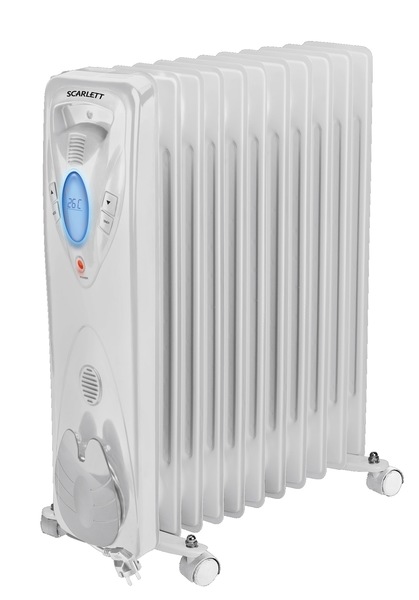
Photo: gooosha.ru
Heater power
The second important criterion is the power of the device. Even if you buy the most expensive ceramic heater with a power of 0.5 kW, it will not be able to heat even a room of 10 m².
To understand how much power you will need, measure the area of the room and the height of the ceilings in it. We will reason based on the standard height of 2.5 m.
- Up to 6m² - 0.5kW;
- Up to 10 m² - 0.75 kW;
- Up to 15 m² - 1.25 kW;
- Up to 18 m² - 1.5 kW;
- Up to 25m² - 2kW.
Additional features
- Timer will allow you to use electricity as efficiently as possible. Agree, it won’t be very pleasant to see a large amount in your electricity bill at the end of the month just because you forgot to turn off the heater several times before leaving for work.
- Availability thermostat The heater has another useful function in everyday life. The thermostat will help the heater maintain the desired temperature at all times: it will turn on and off automatically when the air temperature drops or reaches a certain level.
- Wheels will make your life much easier, because moving the heater from room to room will be difficult.
- Multiple operating modes will save electricity consumption. Agree, you don’t always need to quickly warm up a cold room; sometimes you just need to raise the temperature a little.
The best heater manufacturers
Since there are many types of heaters, and many manufacturers produce more than one type, we will focus on the cost of the devices.
- Economy class heaters can be purchased at prices ranging from 400 to 2000 rubles. In this range you can choose thermal fans, oil, infrared, carbon heaters. You can safely purchase products from companies such as Timberk, Polaris, Ballu, VITEK, BORK, Rolsen, SUPRA.
- The average price segment - from 2 to 5 thousand rubles - is represented, for the most part, by convector and infrared heaters from the following manufacturers: Elecrolux, Vitesse, Timberk, Shivaki, NeoClima.
- We classify heaters priced above 5,000 rubles as premium. Here you will have to choose mainly from convector-type devices. The leaders in this group are Noirot, Nobo, Shivaki, Electrolux, Stadler, BORK, Delonghi.
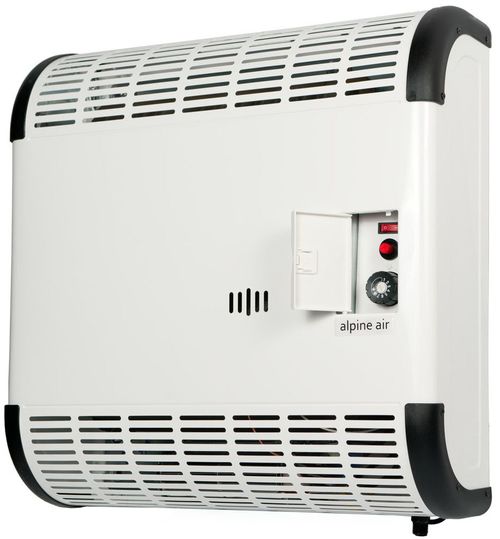
Photo: www.energoblok.ru
Common Buyer Mistakes
- Buying a heater without a quality certificate may result in short circuits, fires, etc. unpleasant things. The certificate confirms that the wires and materials comply with the standards. If there is no certificate, then you should not rely on chance.
- Buying a heater other than a convector for a house with small children is a doubly rash act. They are the safest, although they are more expensive. But there is no need to save on children's health.
- Heaters without a built-in fan warm up the room very slowly. If you don’t want to wait forever, chattering your teeth from the cold, check with the seller for the presence of a fan in the selected model.
We wish you happy shopping and warm family evenings at home!
What is infrared heating?
Have you ever had to bask in sun rays, while the thermometer showed a temperature below zero? If you have, then you probably have a desire to experience this unforgettable feeling many more times.
Infrared heaters, about which we'll talk, create the same thermal effect as the sun. They send heat rays that are absorbed by the surfaces of walls, floors, and furniture, and they, in turn, give off this heat to the surrounding air.
What is infrared heating?
First, let's recall some basic concepts. Any heated body gives off heat to the objects surrounding it in three ways:
- using thermal conductivity (heat exchange between two bodies through the interface between them),
- convection (the process of heat transfer by heating a liquid or gas flowing around a heated body, and from them surrounding objects)
- and thermal radiation ( electromagnetic radiation in the infrared wavelength range emitted by the body).
In principle, an infrared heater can be considered any heated body that gives off heat mainly by radiation, while other ways of heat transfer from it are minimized.
To make it even clearer, let’s imagine a familiar heating radiator. If it is installed on a wall, heat is transferred from it in two ways: convection, that is, heating the air flowing around the radiator (about 80%), and radiation (about 20%). If the same radiator is placed under the ceiling, the convective component will be reduced to a minimum and what will remain is mainly radiation, which can be enhanced by installing a reflector behind the radiator. As a result, we will get a device that, in principle, can be called an infrared heater.
What are IR rays?
Infrared (IR) rays are electromagnetic radiation that obeys the laws of optics and therefore has the same nature as visible light. These rays occupy the spectral region between red visible light (wavelength 0.74 μm) and short-wave radio emission (1-2 mm). In turn, the infrared region of the spectrum is conventionally divided into short-wave (from 0.74 to 2.5 microns), medium-wave (2.5-50 microns) and long-wave (50-1000 microns) parts. Infrared rays are emitted by all heated solids and liquids. In this case, the length of the emitted wave depends on the body temperature - the higher it is, the shorter the waves and the higher the radiation intensity. Principle of IR heating Thermal radiation from an IR heater (hereinafter referred to as ICO), as we found out, is not absorbed by the air. Therefore, all the energy from the device reaches objects and people in its coverage area almost without loss. And it heats them, and not the air, as happens when using convectors. In other words, heat from the ICO is transferred, first of all, to solid objects (floor, walls, furniture, etc.), and from them to the air. Naturally, the closer to the ICO, the denser the heat flow and the higher the temperature of the objects. Moreover, heat release from the PCI occurs only in its zone direct action, that is, heating is local in nature. This provides the ICO with a number of features, some of which are very useful in consumer terms.
Firstly, when using ICO, warmer air practically does not accumulate under the ceiling, which is typical, for example, for convective heating (in this case, warm air in high rooms even has to be forcibly returned downwards using ceiling fans). To put it simply, ICOs are those heating devices that perfectly implement the old medical wisdom: “Keep your feet warm and your head cold.” This feature of ICO operation makes them practically irreplaceable when solving problems of economical heating of rooms with high ceilings. After all, heating a large volume is technically difficult and therefore expensive. Such emitters are also useful for situations where only certain (working) zones require heating or when the creation of convective air flows, and therefore flows of dust contained in it, is undesirable (this is an important requirement for allergy sufferers).
Secondly, when using local “reheating” using ICO zones in which people are located, you can reduce the temperature created by the main heating system in the entire room by several degrees. In this case, the “felt” temperature will remain unchanged, since the decrease general temperature air will be compensated by the IR “additive” absorbed directly by the human body. Thus, the use of infrared heaters leads to lower energy consumption and lower heating costs compared to traditional ways its implementation.
Thirdly, ICOs, mounted under the ceiling or even built into it, do not impose any restrictions on the placement of furniture and equipment.
Fourthly, with the help of ICO it is possible to solve specific problems that simply cannot be solved in any other way. This could be, for example, protection from the cold blowing from the glass of tall stained glass windows, domes, large windows and similar translucent structures, since their heat-shielding properties, as a rule, are very far from modern standards. ICO aimed at such a structure not only creates an effective thermal barrier against cold, but also solves the problem of cleaning structures from snow and ice. Moreover, the cleaning is of such quality that even “golden” human hands are hardly capable of - the ICO heats the structure, as a result of which the snow and ice simply melt. By the way, the problem of clearing snow and ice from the steps of the porch, the path leading to it, and exits from garages located below ground level is solved in a similar way.
Long wave heating can be compared to lighting. By correctly distributing light sources in the room, you can ensure that the lighting becomes uniform and, therefore, comfortable. In the same way, if you correctly distribute infrared heaters over the area of the room, you can get not only uniform and comfortable heating of the room, but also energy savings. Power infrared heaters is selected depending on the type of room and ceiling height, the material of walls, ceilings, the number and area of glazing, the presence of doors, the degree of insulation of the ceiling, roof, and the nature of the building’s foundation.
Having first calculated the total power necessary to heat the room as a whole, you can then find the power of the heaters required to distribute heat evenly in the room. When making calculations, it is necessary to take into account the height of the ceilings, the total power consumption, as well as the type of room in which it will be used.
Below are tables that allow approximately define required quantity infrared heaters for your premises.
There is a wide variety of formulas, tables for calculating and selecting the power of heaters, but not a single calculation can accurately determine the required power for each specific case. All of them give approximate selection results for standard conditions in which the room is located. What is meant by standard conditions?
- air temperature that must be maintained in the room. Usually +20C is taken for calculations.
- standard thermal insulation of a house or room, which is calculated based on the average seasonal air temperature.
- the room has a ceiling height of no more than 2 meters 70 centimeters.
- The premises are one-story.
Not many people will be satisfied with the temperature of the maintained air in the room +20C. It can be significantly higher.
The average seasonal outdoor temperature differs from everyday temperatures and is often significantly lower than average. In this case, the amount of heat generated by the heaters does not compensate for the cold entering the room. This situation has a deplorable effect not only in moments low temperatures, but also in the future, since the room is cooled, not receiving enough heat. On all subsequent days, the heaters will have to warm up the room, and this may take more than one day, and all this time it will seem that the room is cold.
In private houses and cottages, ceiling heights range from 3 to 5 meters. The higher the ceiling, the more hot air rises and remains there, and an adult estimates the air temperature at the level of his height, on average - 175 cm, and the air at this level is much colder.
Not all modern rooms intended for heating are one-story. For multi-storey premises with a common communicating space, the calculations become significantly more complicated. Warm air from the lower floor rises and, to a greater extent, heats not the lower floor, but the upper one.
With any calculation of power consumption, errors are allowed, so the choice of selection method is up to the user himself. You can offer a quick and universal method of calculation when 1000 W is chosen for 10 sq.m. taking into account that the ceiling height is approximately 270 cm. All other parameters can be adjusted during operation of the heating system. Moreover, there is a false idea that installed in a room of 20 square meters. m, one 2000 W heater will work more economically than four 500 W heaters. Most likely it’s the other way around, since more heaters will heat the entire volume more evenly and, accordingly, faster.
Manufacturer convectors Nobo recommends using tabular data for selecting your convectors.
| Room area | Convector power |
| up to 10 sq.m | 500 W |
| 8- 15 sq.m | 750 W |
| 10-18 sq.m | 1000 W |
| 15-22 sq.m | 1250 W |
| 18-25 sq.m | 1500 W |
| 22-30 sq.m | 2000 W |
There are, however, also rules for the correct and rational placement of convectors for heated rooms. Neglecting them, all calculations made will greatly diverge from the real picture of the distribution of air temperature flows throughout the heated volume.
- Convectors must be installed in places with the greatest supply of cold air: under windows, along solid walls that border directly on the outside air and avoid installation in drafts.
- with a ceiling height above 3 meters, for each meter of height it is worth adding 25-30% of the heater power.
- when placing heated rooms on two floors, which have a common space with free exchange of air from one floor to another, you should select heaters with 25-35% more power for the first floor, and 25-35% less for the second floor.
Convectors Nobo can be used as heating devices for main heating or as additional temporary heating. If the room already has some kind of heating method, then when calculating the power of convectors, it is necessary to subtract the power of the main ones from the total calculated power heating devices, and select convectors based on the remaining power. But in any case, the calculation method is up to you to choose.





